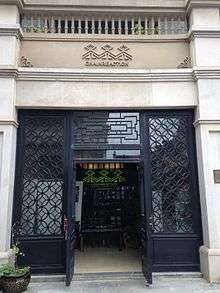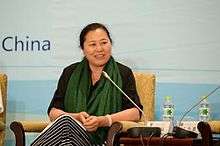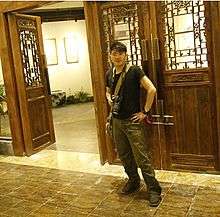Guizhou Rural Tourism Development Center
 | |
| Type | Non-profit organization |
|---|---|
| Location |
|
Key people | Dean Zhang Xiaosong, Guizhou Normal University, School of International Tourism and Culture |
| Affiliations |
Chain Reaction NGO Time Town Guizhou |
The Guizhou Rural Tourism Development Center (贵州乡村旅游发展中心) was founded in 2006 and was then approved by the Guizhou People's Congress as a non-profit organization. It is devoted to preserving, protecting and developing the diverse culture and non-material heritage of ethnic minority groups in southwest China, particularly their beautiful handicraft art.
History
The Guizhou Rural Tourism Development Center was founded by Zhang Xiaosong (张晓松) in 2006. Zhang Xiaosong is the Dean of Guizhou Normal University's School of International Tourism and Culture and one of the World Tourism Organization's seven international experts.[1] The center was originally located at Guizhou Normal University, but then opened shop in Time Town Guizhou (时光贵州) in 2014, a tourism business center located in Qingzhen City, half an hour outside of Guiyang.[2]

Handicraft Art
Cultural Themes
The Chinese sweet gum tree gave birth to Mother Butterfly, who then fell in love with Water Droplets. The two of them had twelve eggs, though Mother Butterfly could not properly take care of them. She then called upon Fortune Chicken to help brood them. After Fortune Chicken brooded over them for forty nine days the eggs hatched and out came a dragon, snake, tiger, water buffalo, centipede, thunder and the founder of the Miao people, Chi You. As such, the Miao people highly venerate Mother Butterfly as their founder and use her symbolic image in many of their handicrafts.
Seven Types of Art
- Batik Art (蜡染)
- Embroidery Art (刺绣)
- Ceramic Art (陶瓷)
- Old Paper Art (纸艺)
- Weaving Art (织艺)
- Silver Art (银艺)
- Wood Carving (木雕)
-

Batik Art
-

Embroidery Art
-

Ceramic Art
-

Old Paper Art
-

Weaving Art
-

Silver Art
-

Wood Carving
Artisans
Zhang Chunfeng
Zhang Chunfeng (张春风) specializes in making different types of wood carvings. In light of the environmental hazards associated with root carvings, He has pioneered the development of branch carving.[3] Below is an article he wrote on the subject:

The Recovery of Life
"Tree branches serve as the basis for this new style of wood carving which seeks to create art from such objects. Tree stumps, damaged branches and dead tree trunks are also used as material.
Branch carving is a relatively new development and you would be hard-pressed to find examples of it among other forms of wood art.
Branch carving represents a transformation from death to life. This style of art uses material that has been abandoned as trash, that has been discarded by large trees and that has ultimately decayed and died. Mother nature has endowed these branches with life-reflecting inspiration, as evidenced through their many different forms and shapes. The artist draws upon his own perceptions of nature and humanity, combined with the inherent inspiration within the branches themselves, to endow the branch carving with additional artistic vitality. Branch carving regenerates that which was rotten, leading to the recovery of life.
Reflecting not only nature's inspiration, branch carving also serves as a portrait representing humanity's spirit and essence. As we utilize our creativity and look more intently we will discover that even rotten and decayed objects have magnificent beauty and life.
Every branch carving is individually unique, specially designed in accordance with nature's endowment of inspiration. The artist does not dare add any additional color or subjective fabrication to his carvings, but takes care to follow closely nature's special endowment given to each branch.
Branch carving preserves the essence of wood carving while imbuing its product with new life. In addition, this art form is environmentally friendly and does not entail the mass destruction of rare trees as it strives to follow the laws of nature."
(Translated from Mandarin Chinese to English)

Yang Eryeniu
Yang Eryeniu (杨二耶牛) is commonly referred to as Yang Laoshi (Teacher Yang) and she specializes in making batik art. She is a member of the Miao ethnic minority group and her art and dress reflects her cultural heritage. Each of her artistic products is unique as she draws upon her own experiences and Miao folklore for inspiration in producing beautiful pieces of batik art.[4][5][6]
Other Design Artists
-

Tian Cheng (田诚)
-

Li Chunyu (李春雨)
-

Wu Kun (武昆)
-

Leng Qiong (冷琼)
-

Guo Shuangqin (郭双琴)
Outreach Initiatives
"For Our Daughters—Preserve and Protect Guizhou Minority Women Handicraft Art Program" [7]
Partner Organizations

- Shanghai World Expo (Bureau of International Expositions, BIE) [8]
- United Nations World Tourism Organization, Regional Programme for Asia & Pacific [9]
- Ohio State University, Department of East Asian Languages and Literature (https://deall.osu.edu/)
- Ohio State University, National East Asian Languages Resource Center (http://nealrc.osu.edu/)
- Ohio State University, Critical Language Scholarship Program [10]
- University of Notre Dame, Liu Institute for Asian Studies [11]
- University of California, Berkeley: Department of Anthropology [12]
- University of Aveiro (Portugal), Department of Economics, Management and Industrial Engineering
- Hong Kong Federation of Women [13]
- China National Tourism Administration [14]
- China Development Bank, Education and Training Department
- Guizhou Province Tourism Bureau (http://www.gztour.gov.cn/en/)
- Tsinghua University, Research Center for Anthropology & Ethnology [15]
- Shanghai Jiao Tong University [16]
- Guizhou Normal University, School of International Tourism and Culture [17]
- Chinese Academy of Social Sciences, Institute of Ethnology and Anthropology
- etc.

International Recognition
- 2010, UNESCO: Award of Excellence for Handicrafts (4 Pieces)
- 2011, “For Our Daughters—Preserve and Protect Guizhou Minority Women Handicraft Art Program” won a BIE-Cosmos award at the 2010 Shanghai World Expo (It was the only award given that year to a charity organization)
- 2016, CNN listed Guizhou as China's most underrated region[18]
- 2016, New York Times listed as Guizhou as one of the top places to visit in 2016 [19]
References
- ↑ "教师风采-国际旅游文化学院". lyxy.gznu.edu.cn. Retrieved 2016-06-25.
- ↑ "时光贵州". www.gzsggz.com. Retrieved 2016-06-25.
- ↑ http://www.xici.net/. "雕刻在檬子木上的年轻艺术力量_贵阳人创业_职场_西祠胡同". www.xici.net. Retrieved 2016-06-20.
- ↑ "杨二耶牛艺术家简介". yeyn.zxart.cn. Retrieved 2016-06-20.
- ↑ "【乡村艺术家】杨二耶牛". xyz.gydpx.org. Retrieved 2016-06-20.
- ↑ "杨二耶牛 - 艺术名家 - 中乡办传统文化保护部". www.pro-ch.com. Retrieved 2016-06-20.
- ↑ "贵州师范大学:张晓松教授主持的"For Our Daughters"项目获奖侧记_华文教育". www.kaoyan001.com. Retrieved 2016-06-19.
- ↑ "BIE - Bureau International des Expositions". www.bie-paris.org. Retrieved 2016-06-19.
- ↑ "Regional Programme for Asia & the Pacific | Committed to Tourism, Travel and the Millennium Development Goals". asiapacific.unwto.org. Retrieved 2016-06-19.
- ↑ "The CLS Program - Critical Language Scholarship Program". www.clscholarship.org. Retrieved 2016-06-19.
- ↑ Dame, ENR/PAZ // University Communications: Web // University of Notre. "Liu Institute for Asia and Asian Studies // University of Notre Dame". asia.nd.edu. Retrieved 2016-06-19.
- ↑ "Home". Anthropology Department, UC Berkeley. Retrieved 2016-06-19.
- ↑ "Hong Kong Federation of Women". www.hkfw.org. Retrieved 2016-06-19.
- ↑ "National Tourism Administration of The People's Republic of China". en.cnta.gov.cn. Retrieved 2016-06-19.
- ↑ "Department of Sociology, Tsinghua University". www.tsinghua.edu.cn. Retrieved 2016-06-19.
- ↑ "Jiao Tong University - Home Page". en.sjtu.edu.cn. Retrieved 2016-06-19.
- ↑ "Schools of GZNU-Guizhou Normal University". e.gznu.edu.cn. Retrieved 2016-06-19.
- ↑ CNN, Katie Hunt. "Guizhou: China's most underrated region". CNN. Retrieved 2016-06-25.
- ↑ "52 Places to Go in 2016". The New York Times. 2016-01-07. ISSN 0362-4331. Retrieved 2016-07-05.